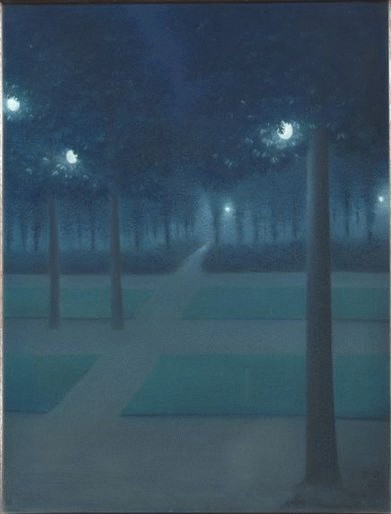Next to my desk is a postcard copy of William Degouve de Nunques’s 1897 painting Nocturne au parc royal de Bruxelles. An image of the painting appears at the beginning of this post.
Paintings that move us do so in a wordless language, but we are caught by words in our attempt to explain their effects. For example, I can describe how this picture affects me: a romantic image, it promises the possibility of an otherworldliness found within the ordinary become extraordinary – the same scene in full sun would lose its mystery. The gas lamps appear to be suspended from trees. That does not make sense. A closer look – those gas lamps appear to be like strange moons, hovering above pathways, and in the distance, the direction I would follow, the direction I think that de Nunques wants the eye to follow, we see a path, deepening within more trees, that fades into a mist. The impressions I feel are made up of fleeting memories and emotions – late at night awakening in bed as a boy in summer and looking out the open window onto Woodside Avenue where a corner streetlight was partially obscured and then cleared and obscured again and so on by the leaves of the big maples moving in the wind. Only the wind and the leaves moving in the wind made a sound. The whole world seemed to be still, and only I was awake, almost waiting for a silhouette to step into the light. Unafraid, I wanted the mystery to deepen.
Paintings call out the unconscious patterns in our minds, the archetypal patterns. For example, how often have you looked into a lit darkness filtered by mist? How many times have you watched a street like this, looked out a window at a park or cityscape that has a similar sense about it? How often have you come across a scene like this in a photo, movie, novel, song, story? I would bet more times than we can track.
Unlike some paintings, this picture beckons us inside. It is intimate. It promises intimacy, but a spooky kind, one where you would be hyper-alert to sounds, to shadows, to movement.
All those words … and yet they don’t feel as if they touch the heart of the heart of the appeal of Nocturne. Beyond language, beyond analysis, there is only the silence of this landscape and the five globes of ligh t(which cannot provide all the light in the painting) and the air itself which seems lit from within its atoms. Wouldn’t it be lovely to walk there?
